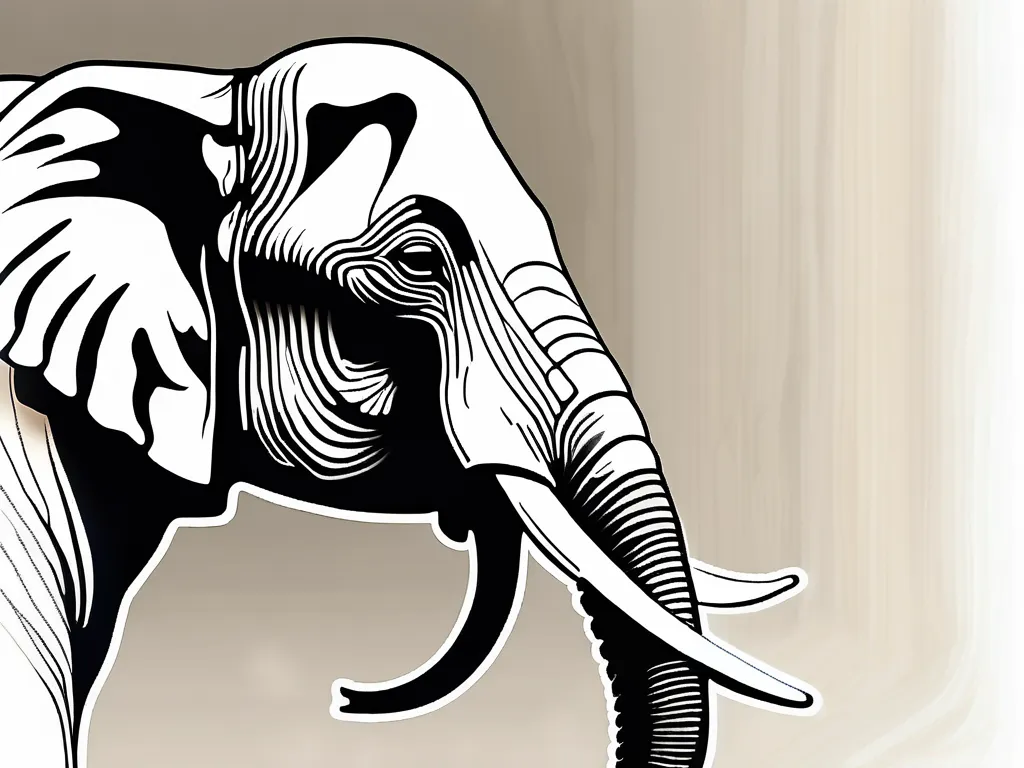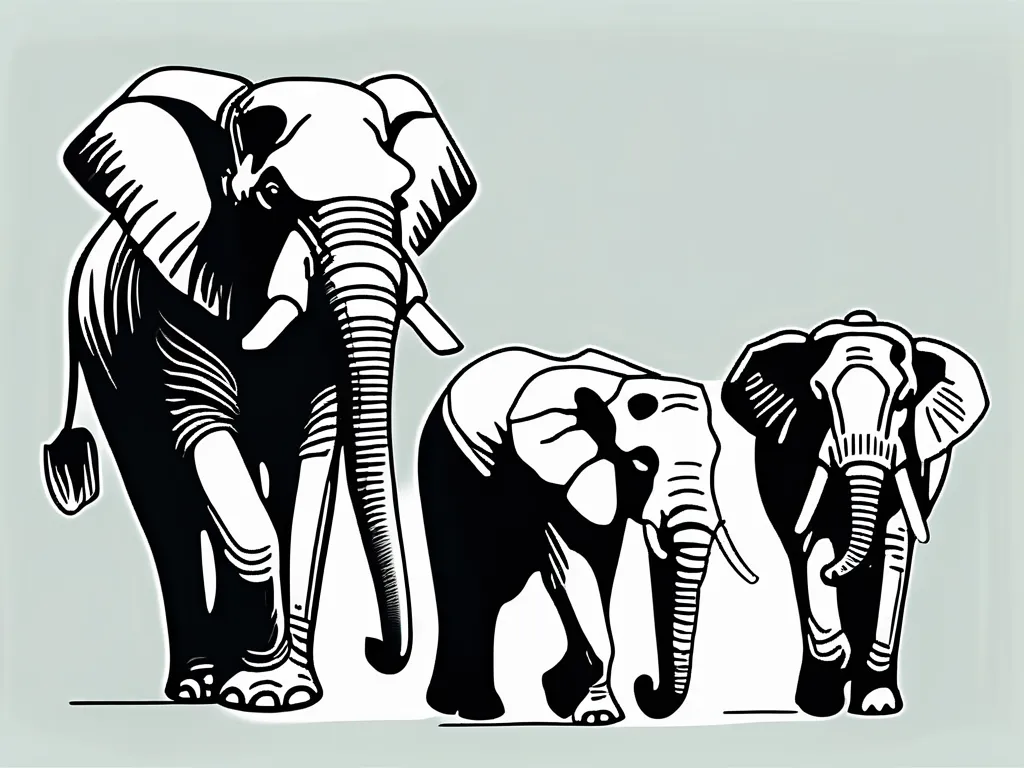Did you know that elephants are some of the most incredible creatures on our planet? These majestic beings are not only massive in size but also possess astonishing intelligence and social structures. Join us in exploring the realm of these fascinating beings and delving into the wonders of their existence.
Understanding the Elephant: An Overview
Before we dive deeper into the world of elephants, let’s start with an overview of these incredible creatures. Elephants are part of the Proboscidea order, which includes both living and extinct species. The two main species we are familiar with are the African elephant and the Asian elephant. Let’s discover the difference between these two magnificent beings.
Elephant Species: African vs Asian
The first thing to note is the size difference between African and Asian elephants. African elephants are the largest land animals, with males standing up to 10-13 feet tall at the shoulder. In contrast, Asian elephants reach an average height of 6-11 feet.
Another significant distinction lies in their ears. African elephants have much larger ears compared to their Asian counterparts. These enormous ears serve as excellent thermal regulators, helping them cool down in the scorching African landscapes.
Fascinatingly, both species have tusks, but there are variations in size and appearance. While both male and female African elephants generally have tusks, only male Asian elephants tend to possess them.
The Elephant’s Lifespan
The average lifespan of an elephant in the wild varies between species. African elephants typically live for 60-70 years, while Asian elephants have a slightly shorter lifespan of 48-60 years. However, some individuals have been known to live well into their 80s and 90s, displaying the remarkable endurance and resilience of these gentle giants.
Elephant Anatomy: Size, Weight, and More
Elephants are renowned for their impressive size and weight. An adult male African elephant can weigh up to a staggering 12,000 pounds, while females can reach 8,000 pounds. Asian elephants are slightly smaller, with males weighing around 9,000 pounds and females weighing approximately 6,000 pounds.
Their trunks, a defining characteristic of elephants, are versatile and multi-functional. These elongated appendages serve various purposes, from feeding and drinking to social interactions and even as a snorkel when swimming!
Furthermore, elephants’ tusks, which are elongated incisor teeth, continue to fascinate scientists and enthusiasts alike. These ivory tusks can weigh over 100 pounds in some cases and serve multiple functions, including defense, foraging, and digging for water in dry riverbeds.

The Social Life of Elephants
Beyond their physical attributes, elephants have a rich social life that is both complex and captivating. Let’s venture into the realm of elephants’ intricate social structures and communication methods.
Elephant Herds: A Matriarchal Society
Elephants live in close-knit herds comprised of related females and their offspring. These herds are led by a wise and experienced female called the matriarch. The matriarch plays an essential role in guiding the herd, making crucial decisions about food sources, migration routes, and potential threats.
Female elephants have incredibly strong bonds with each other, forming lifelong relationships within their families. These social connections ensure that knowledge and wisdom are passed down from one generation to the next.
Communication Among Elephants
Communicating within the herd is vital for elephants to thrive and survive. These intelligent beings have a repertoire of communication methods, including vocalizations, physical gestures, and even seismic vibrations.
One vocalization method unique to elephants is the low-frequency rumble, which can travel up to several miles. This rumbling sound serves as a way for elephants to communicate and connect with distant relatives, as well as a means of expressing emotions like happiness, fear, or distress.
Elephants also use body language to convey messages. Flapping their ears, wagging their tails, and trumpeting are just a few of the gestures elephants employ to communicate intentions, dominance, or to signal danger to others in the herd.
Mating and Reproduction in Elephants
Elephants have fascinating mating rituals and reproductive cycles. Female elephants, also known as cows, reach sexual maturity around the age of 10-12 years old. They typically give birth to a single calf after a gestation period of approximately 22 months, making it the longest gestation period of any land mammal.
Once born, the calf remains under the intense care and protection of its mother and the extended family. This nurturing behavior helps the calf develop and learn vital survival skills from experienced members of the herd.
Elephants in the Ecosystem
As awe-inspiring as they are, elephants play a crucial role in maintaining the health and balance of their natural habitats. Let’s delve into the ways elephants contribute to their ecosystems.
The Role of Elephants in Their Habitat
Elephants are often referred to as “ecosystem engineers” due to their impact on the environment. They help create and modify their surroundings in ways that benefit various other species.
One of the most notable examples is their influence on vegetation. Elephants have enormous appetites, consuming up to 300 pounds of food each day. While grazing, they unintentionally clear grasslands, which opens up opportunities for new plant growth and provides habitats for smaller wildlife.
Furthermore, elephants also aid in seed dispersal through their dung. Seeds that pass through their digestive system are often deposited in new areas, facilitating plant reproduction and supporting biodiversity.
Elephants and Biodiversity
Due to their ability to modify landscapes, elephants contribute significantly to the diversity of ecosystems they inhabit. By clearing away vegetation, they create patches of open space that attract a variety of animals, including birds, grazing ungulates, and insects.
Their feeding habits also promote balance within ecosystems, preventing certain plant species from becoming dominant and allowing others to thrive. This intricate connection between elephants, vegetation, and wildlife demonstrates their vital role in maintaining biodiversity.
Elephants as Keystone Species
Another remarkable aspect of elephants’ impact on the environment lies in their role as “keystone species.” A keystone species is one that has an essential influence on its ecosystem, shaping the structure and functioning of the habitat.
Elephants fulfill this role by creating habitats for other animals, influencing the distribution and composition of plant species, and even shaping the physical landscape through their browsing, trampling, and feeding behaviors.
Without elephants, many ecosystems would look drastically different, highlighting the indispensability of these incredible animals for the overall health of our planet.
The Elephant’s Intelligence
While elephants’ physical attributes and social structures are awe-inspiring, their intelligence is equally astonishing. Let’s delve into the remarkable cognitive abilities possessed by these majestic creatures.

Memory and Learning in Elephants
Elephants have prodigious memories, capable of recalling intricate details about their environment, social connections, and even specific individuals they encountered years ago. Their remarkable memory aids them in navigating vast territories, locating water sources, and recognizing potential threats or friendly faces.
Moreover, elephants exhibit impressive learning capabilities. They can adapt to new situations, solve complex problems, and learn from observing and mimicking other elephants. These abilities showcase a high level of cognition present within these gentle giants.
Problem-Solving and Tool Use
Elephants have also been observed using tools, a behavior once thought to be unique to humans and a few other species. In some regions, elephants have been observed using branches or sticks to swat at flies or to scratch themselves on hard-to-reach places.
Furthermore, elephants have demonstrated problem-solving skills, such as using rocks to dig for water or employing teamwork to overcome obstacles. These behaviors highlight their resourcefulness and adaptability, further underscoring their intelligence.
Emotional Intelligence in Elephants
One of the most remarkable aspects of elephants’ intelligence is their emotional sensitivity and empathy. These sentient creatures display a wide range of emotions, including joy, grief, anger, and even self-awareness.
Elephants are known for their deep bonds and expressions of compassion within their herds. They comfort and console one another during times of distress, demonstrating a level of empathy and understanding that is truly awe-inspiring.
Elephant Trivia: Test Your Knowledge!
How many species of elephants are there? Is it:
a) 1
b) 2
c) 3
d) 4In which continent can you find African elephants?
a) Africa
b) Asia
c) Europe
d) AustraliaWhat is the primary material in an elephant’s tusks?
a) Wood
b) Bone
c) Ivory
d) metalHow long is the average gestation period of an elephant?
a) 3 months
b) 9 months
c) 22 months
d) 19 monthsWhich species of elephant has a matriarchal society?
a) African elephants
b) Asian elephants
c) Indian elephant
d) All three of themHow do elephants communicate with one another over long distances?
a) By singing
b) By using seismic vibrations
c) By texting
d) By sonar wavesHow much can an adult male African elephant weigh?
a) 1,000-3,000 pounds
b) 6,000-8,000 pounds
c) 12,000-14,000 pounds
d) 18,000-20,000 poundsWhat is the lifespan of an elephant in the wild?
a) 60-70 years
b) 40-50 years
c) 20-30 years
d) 80-90 yearsWhat is the main diet of elephants?
a) Grass
b) Fruits and Vegetables
c) Meat
d) LeavesWhat is the name of the long, flexible appendage of an elephant?
a) Tail
b) Trunk
c) Proboscis
d) Snout

So, how did you do on the elephant trivia? Did you manage to impress yourself and others with your knowledge about these majestic creatures? Whether you knew every answer or learned a few new things, there is no denying the awe-inspiring qualities of elephants.
From their astounding physical attributes and intricate social structures to their remarkable intelligence and impact on ecosystems, elephants continue to captivate our imagination and inspire our admiration.
Next time you see an elephant, take a moment to appreciate the wonders of these gentle giants and the vital role they play in our world. Let’s continue to champion their conservation and ensure the survival of these magnificent creatures for generations to come!
- c) 3
- a) Africa
- c) Ivory
- c) 22 months
- d) All three of them
- b) By using seismic vibrations
- c) 12,000-14,000 pounds
- a) 60-70 years
- d) Leaves
- b) Trunk



